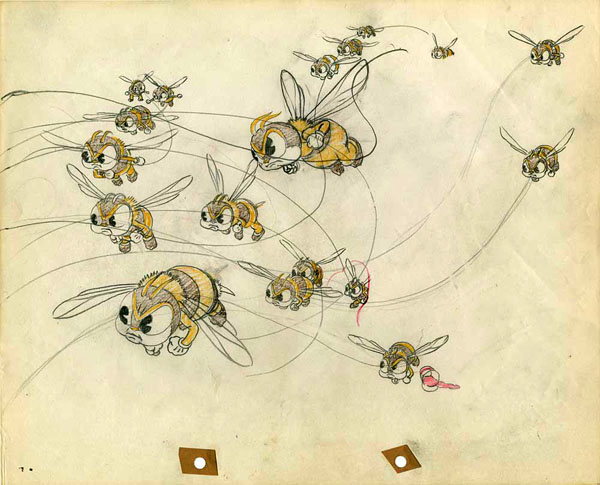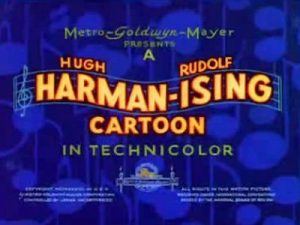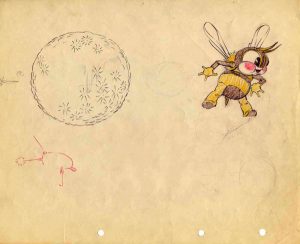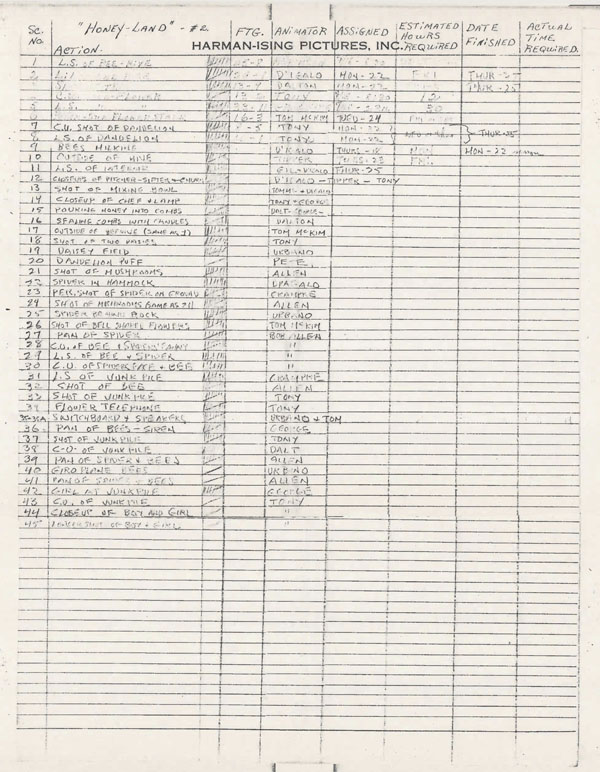
In this weeks breakdown, well see whats the buzz is all about in this Harman-Ising Happy Harmonies cartoon!
Disneys contract to use the full three-strip Technicolor process in his films expired in September 1935. In that same time, the Harman-Ising studio released The Old Plantation, their first Happy Harmonies released in full Technicolor. (Ted Esbaughs adaptation of The Wizard of Oz, in production around 1932 and released in 1933, was intended as a test for the color process before Disney negotiated his deal with the corporation with Flowers and Trees.) Honeyland was released to theaters the following month, in October. In the first half of the film, a colony of busy bees gather nectar from various flowers to manufacture honey in their beehive factory – all in rich, vibrant Technicolor splendor.
 Harman and Ising had produced the Happy Harmonies for MGM for over a year by the time this film went into production. The print cost from a number of their films was one factor that led to the termination of their agreement with the studio. Honeyland runs ten minutes in length; the activity scenes with the bee colony, as they collect and produce honey, detracts from the boy and girl couple, who are not seen until four minutes into the film. As a conscientious story editor – though, on occasion, his short cartoons would be hindered by similar problems – Walt Disney would have excised much of these sequences to focus on the main characters. In Harman-Isings case, it could be presumed director Rudy Ising believed these lavish components were too valuable to waste, no matter how superfluous.
Harman and Ising had produced the Happy Harmonies for MGM for over a year by the time this film went into production. The print cost from a number of their films was one factor that led to the termination of their agreement with the studio. Honeyland runs ten minutes in length; the activity scenes with the bee colony, as they collect and produce honey, detracts from the boy and girl couple, who are not seen until four minutes into the film. As a conscientious story editor – though, on occasion, his short cartoons would be hindered by similar problems – Walt Disney would have excised much of these sequences to focus on the main characters. In Harman-Isings case, it could be presumed director Rudy Ising believed these lavish components were too valuable to waste, no matter how superfluous.
The draft for Honeyland lists dates for each scene assigned, but doesnt reveal the month in which they were assigned. Like other Harman-Ising cartoons, the draft is parceled out in blocks of scenes to the animators, one after another, with only a few artists given extended sequences. In the interior scenes in the beehive, with the exception of scene 16 (animated by Cal Dalton), two animators are jointly credited within one shot; scene 12, alone, is credited to three animators. Since a few of these scenes are crowd shots, it could be assumed each animator worked on different groups of bees within the same sequence. Scene 14, with the chef bee taste-testing his honey, is credited to both Tony Jim Pabian and George Grandpre. The scene is closer to Pabians drawing style, but both names are inserted in the video.
 Ten animators are credited for their work on this film, though Frank Tipper, Gil Turner and Pete Burness are each listed in only one scene in the draft. Tom McKimson, Joe DIgalo, Cal Dalton, Jim Pabian and George Grandpre handle the abundance of scenes with the bee colony before the first scenes of the couple. Pabian animates the boy and girl bee outside of their hive, and standing in a daisy field. Three more animators, Carl Urbano, Pete Burness and Bob Allen are given scenes shortly after the couple is established in the film, as they play a game of hide-and-seek and chase each other around a mushroom.
Ten animators are credited for their work on this film, though Frank Tipper, Gil Turner and Pete Burness are each listed in only one scene in the draft. Tom McKimson, Joe DIgalo, Cal Dalton, Jim Pabian and George Grandpre handle the abundance of scenes with the bee colony before the first scenes of the couple. Pabian animates the boy and girl bee outside of their hive, and standing in a daisy field. Three more animators, Carl Urbano, Pete Burness and Bob Allen are given scenes shortly after the couple is established in the film, as they play a game of hide-and-seek and chase each other around a mushroom.
Bob Allen and Jim Pabian, arguably the two strongest animators during this period at Harman-Ising, are given lengthier sections during the climactic scenes in the film. Allen animates the fight between the boy and the spider, set to the accompaniment of Nikolai Rimsky-Korsakovs Flight of the Bumblee. Jim Pabian handles the fight that continues inside of the junk pile, and the girls escape to make a distress signal to the colony, who immediately fly out to the rescue. (Scene 36, with the bees forming in the shape of a siren – credited to George Grandpre – must have been a difficult scene to animate, and certainly a strenuous task for the ink and paint department.) Allen animates the army of bees and their battle with the spider, with Pabian animating the final scenes with the boy and girl couple.
Thankfully, this photocopy of the handwritten draft is much easier to read, compared to other Harman-Ising titles used in this column. Interestingly, the animators credited to each scene are noted, but the assigned dates for the start and completion, along with the hours required for each scene, are left unfinished. The document reveals the process of how the animators approached their work; scenes 2 and 3 of the worker bees collecting pollen from sunflowers (animated by Pabian and Grandpre), required 12 hours from Pabian and 30 hours from Grandpre.
Enjoy!

Next Week: a McKimson Porky/Daffy cartoon…
(Thanks to Michael Barrier and Steve Stanchfield for their help.)


 DEVON BAXTER is a film restoration artist, video editor, and animation researcher/writer currently residing in Pennsylvania. He also hosts a
DEVON BAXTER is a film restoration artist, video editor, and animation researcher/writer currently residing in Pennsylvania. He also hosts a 





















































































Always a favorite! This is one of the Happy Harmonies that almost justifies the extra length.
Great to see another one of these ID’d!! I love Jim Pabian’s work so much, he was really such a stylish, fun animator in the 30s.
I knew you’d love it, Charlie! If only i could write about Harman’s cartoons, like POOR LITTLE ME or SWING WEDDING. Unfortunately, Barrier only has drafts from Ising’s cartoons (photocopied back in 1979), and I’ve used up all the Harman documents that Kausler has in his collection already.
Basing it’s foundation in terms of Technicolor use on Disney’s “Flowers and Trees” isn’t a big surprise, given how much else Harmon & Ising copied from Walt (and to be fair, Friz Freleng over at Schlesingers also went with flowers for that studio’s first three-color cartoon). But “Honeyland” does expose the fact ngoing problem of H&I that king their animation would offset any need for a strong story structure. Friz’s initial full Technicolor effort and even the Fleischers’ first three-strip cartoon have more engaging story lines.
AND just to complete the above, the Schlesinger short J.Lee mentions was “Flowers for Madame”. Its original open/close have yet to..uh..bee restored. I’]ve seen Honeyland before..typical cute 1930s cartoon.;..:)SC
I would assume that it was the embellishments that drove the cost of Harman/Ising cartoons up so high–the ooey-gooey look of the honey for example, probably complete with a “shine” to signify its stickiness or wetness. I remember how they animated mud when a character would fall into a puddle or go stamping through one.
And, if you think that the insect swarm in *THIS* cartoon may have been tough to animate, imagine the staggering insect effect that ran all the way through most of a later BOSKO cartoon, two years later, called “CIRCUS DAZE”. Yeah, I know I reference this cartoon a lot, but man, that thing had chaotic scene after chaotic scene, and the flea circus infestation got so big that the dots around the screen almost looked like the kind of snow that you’d experience on your TV when good reception would fail you.
Or, perhaps, I should reference a somewhat similar cartoon, “WILD HONEY”, one of the last Rudy Ising BARNEY BEAR cartoons in which the bees advance on ol’ bruin in the extravagantly extraordinary shape of a bomber plane! The difficulty in “HONEYLAND”, however, may have been actually having to animate the individual bees in the advancing army since the spider wasn’t supposed to be much larger than they. But, hey, this is why I enjoyed even the simplest Harman/Ising cartoon from MGM. They truly were almost like mini-movies or featurettes.
If they fully understood characterization and a better pace at story-telling, MGM would surely have had an animated film perhaps even before they had the equally lavish live action spectacle, “THE WIZARD OF OZ”.
Being a lover of the Harman-Ising -not “Harmon” as many “animation historians” spell his last name the Happy Harmonies were one of the best series in the history of the Golden Animation Years. Not only that, Hugh Harman and Rudolf C. Ising were the first ones to make the Looney Tunes comes to life under a contract with Leon Schlesinger.
Kevin, I truly like all your posts. Always very positive and knowledgeable. Thank you, Martin
The months in 1935 that the dates would fall on in the draft are either April or July.
The way bees actually make honey is far less glamorous. It’s also less expensive and requires only one “animator”…the bee itself. The bee sucks nectar from flowers, then returns to the hive and regurgitates it.
I doubt if Harmon or Ising would want to animate barfing bees. If John Kricfalusi decided to remake it however….
Well, nature isn’t exactly pretty as animated films depict it anyway, especially the role queen bees have for the honey process. Yuck!
The singers were H&I favorites, The Rhythmettes, and Ising himself did the spider villain. Enjoyed the piece, thanks Devon.
I’ve always wondered who wrote the title song, “Honeyland.” Of course, “Flight of the Bumble Bee” was used for the fight sequence, and that’s “Let’s Make Hay While the Sun Shines,” by Arthur Freed and Nacio Brown, from the MGM feature “Going Hollywood,” for the courting scene when the boy and girl first meet. But I’ve always wondered who wrote the title song, which I think must have been original.